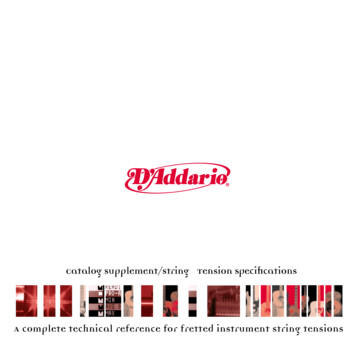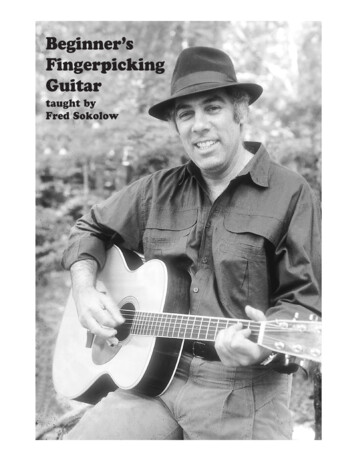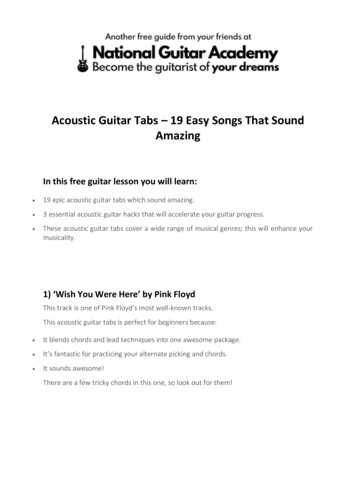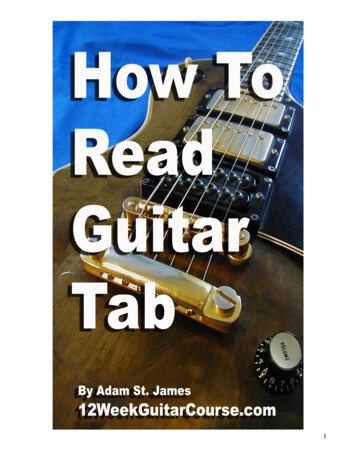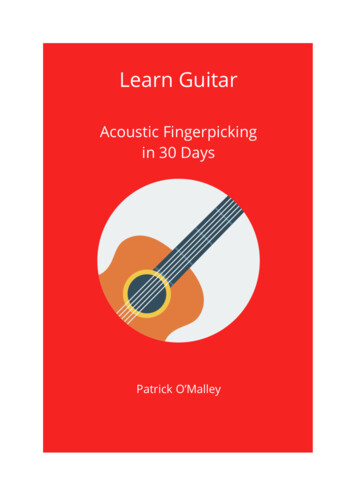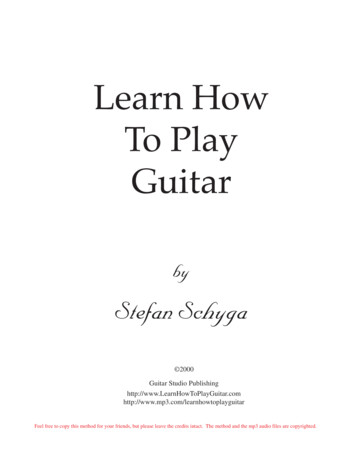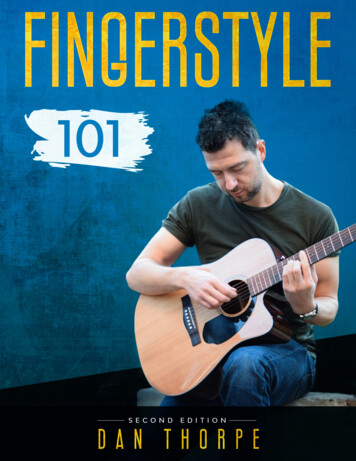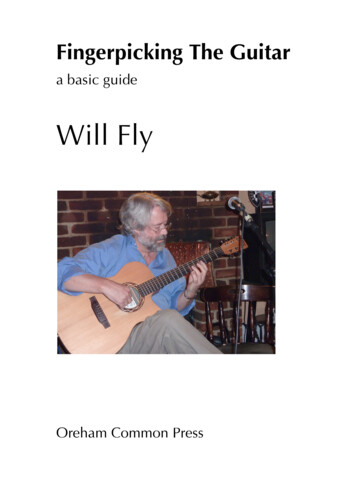
Transcription
Fingerpicking The Guitara basic guideWill FlyOreham Common Press
Fingerpicking The GuitarA basic guideBy Will FlyOreham Common Press, 2011 Will Fly, 2011i
PrefaceI’ve been playing a steel strung guitar with both pick and fingers forover 45 years. The purpose of this little book is to pass on to thebeginning guitar player some of the fingerpicking techniques I’velearned during this time. When I started playing the guitar in 1964, Ilistened to a wide variety of players with very different styles: toMerle Travis and Django Reinhardt; to Big Bill Broonzy and Segovia;to Hank Marvin and Leadbelly. Every one of these players - andmany others – had something to offer to the budding guitarist. Ofcourse, I heard these people on the radio and on record, and nevermet any of them in the flesh. However, I was also lucky enough tomake friends with and play with other, more experienced guitaristsin the places in the north-west where I lived. Each of them taught mesomething in their own way. After a while, like many another beforeme, I got the itch to perform. While some friends formed bands orjoined bands, I was attracted to solo performance and found theworld of the folk clubs to be an ideal place where a beginner like mecould start to learn the arts of playing and performing to anaudience. After moving down to London in 1968, I also joined aband – a jug band, as it happened – and, over the following years,went on from folk, blues and ragtime to play 1920s dance music,jazz, rock’n roll, Memphis soul – and ceilidh music! I still enjoyplaying all these types of music in various ways and in variousplaces. And, whatever style I play, I keep the fingers picking away atthose steel strings. I hope this book inspires you to do the same.Will Fly. 2011ii
IntroductionDiagrams form a major part of this book, so some preliminaryexplanation of how they look and what they mean is in order here.Here is a typical diagram showing the fretboard of the guitar:In this book, the conventions are as follows:1.The title of the song or part of the song being demonstrated isshown in the box on the top left of the diagram.2.Below the title box is the chord shape box showing what chordis being fretted.3.Below the chord box is a box showing the bar and in whichbeat of the bar the chord is being played.4.Blue circles indicate notes which are fingered but not played;yellow circles indicate notes which are fingered and played; ared X at the top of the fretboard means “don’t play this string”.5.Some diagrams also include bars showing barred and halfbarred chords.iii
Other diagrams contain music and tablature. They look like this:Notes with the stems pointing down are played with the thumb;notes with the stems pointing upwards are played with the fingers.The musical notation gives a clear indication of the duration of thenotes and the tablature numbers show the strings and frets whichmake the notes sound on the fretboard. Underlying chords to a tuneare shown below the tablature staff.The book does not contain information or instructions on how tohold the guitar or on the playing of basic chord shapes – it assumesthat the reader has some knowledge of these things already.However, I do have one piece of advice regarding the little finger ofthe picking hand. Many fingerpicking guitarists – some very wellknown ones - rest that finger on the face of the guitar as a kind ofanchor. My view on this is that it restricts the movement of thepicking hand and puts it into an unnatural position. Start by restingthe picking fingers on the strings as described in Chapter 1 and therewill be no restriction on the most complex picking.iv
Most of the examples in the first chapters of the book use a simple Cmajor chord on which to play the fingerpicking patterns, and thepatterns themselves utilise the 5th and 6th strings of the guitar –played by the thumb – and the top 3 strings of the guitar – played bythe first three fingers of the second hand. However, Chapter 9 andthe chapters following take you into more complex territory, so domake sure that you feel comfortable with the contents of Chapters 1to 8 before going further.v
IndexChapter 1: Getting started – alternating thumb & fingers1Chapter 2: An arpeggio played up the chord6Chapter 3: An arpeggio played down the chord10Chapter 4: An arpeggio played up and down the chord13Chapter 5: Alternating treble strings – 3rd with 2nd 1st17Chapter 7: Travis style picking20Chapter 8: Picking different chord shapes22Chapter 9: Patterns played over chord sequences (1)24Chapter 10: Patterns played over chord sequences (2)26Chapter 11: Picking tune no. 128Chapter 12: Picking tune no. 231vi
Chapter 1: Getting started – alternating thumb and fingersThe first thing that the budding fingerpicking guitarist should get togrips with is feeling comfortable with the picking fingers on theguitar strings. To get started, follow these picking hand instructions:1.Rest the thumb on the 5th (A) string.2.Rest the index (1st) finger on the 3rd (G) string3.Rest the middle (2nd) finger on the 2nd (B) string4.Rest the ring (3rd) finger on the 1st (E) stringMany fingerpicking practice and playing patterns can be kicked offfrom this basic position. Now, with these fingers resting on thestrings, hold down a C chord with the fretting hand. The notes beingfretted should be as in Illustration 1 below. (The circles above thenut indicate open strings).Illustration 11
If you now pluck the strings on which your plucking fingers areresting, the yellow notes in the diagram above will be played. Keepyour fretting fingers in the same position on the C chord and movethe thumb on your plucking hand so that it rests on the 6th string. Thenotes being fretted should look like this:Diagram 2This is a C chord, just like the previous chord you played, but with adifferent bass note to it. In the first chord you played the notes C, G,C and E; in the second chord you played the notes G, G, C and E. Inboth cases the bottom note was plucked by the thumb and the topthree notes by the three fingers of the picking hand.What you’re going to do now is to create a simple rhythm byseparating the thumb from the other three fingers. Go back toDiagram 1 on page 1 and place your picking fingers on the 5th, 3rd,2nd and 1st strings. However, instead of plucking all four strings at the2
same time, pluck the 5th string with the thumb and then the top threestrings separately. In diagrammatic terms, the two separate actionsare as in Diagrams 3 and 4 below:Diagram 3Diagram 43
Now go to the finger placement in Diagram 2 and do a similarexercise, i.e. play the 6th string with the thumb and then the top 3strings as a separate beat – as in Diagrams 5 and 6 below:Diagram 5Diagram 64
The music and tablature in Diagram 7 shows exactly what you’vejust played in Diagrams 3-6:Diagram 7This is the beginning of fingerpicking guitar. Repeat this pattern untilyou can get a steady rhythm between the thumb and the threefingers of the picking hand and the alternating thumb of the frettinghand.5
Chapter 2: An arpeggio played up the chordAn arpeggio is a group of notes which are played one after the other,either going up or going down the notes of a chord. Executing anarpeggio requires the player to play the notes of a chord individuallyto differentiate them. Here’s the arpeggio we’re going to play on a Cchord - shown in the music and tablature in Diagram 8 below:Diagram 8Place your picking fingers as they were in Diagram 1 (page 1) andpick the strings as follows:1.Pick the 5th string with the thumb2.Pick the 3rd string with the 1st (index) finger3.Pick the 2nd string with the 2nd (middle) finger4.Pick the 1st string with the 3rd (ring) fingerRepeat the exercise from the position in Diagram 2 (page 2), i.e. pickthe 6th string with the thumb and then the top three strings as ininstructions 2-4 above. Diagrams 9 – 12 below show the first bar,note by note.6
Diagram 9The note above – low C - is played with the thumb.Diagram 10The note above – G - is played with the 1st (index) finger).7
Diagram 11The note above – a higher C - is played with the 2nd (middle) finger.Diagram 12The note above – E – is played with the 3rd (ring) finger. The secondhalf of the arpeggio is the same as the first half – except that the first8
note of the second half is played by the thumb picking the 6th stringinstead of the 5th string. Played at the correct tempo, the wholearpeggio fits into one bar and looks like this:Diagram 13Practice this on a simple C chord with a slight emphasis on thethumb beat to give the rhythm some pulse. Count one-two-threefour, one-two-three-four while playing, and make the notes as equalas possible.And here’s an important piece of advice which applies to all thepatterns in this book: play slowly at first, making sure every notesounds equally. When every note sounds equally, then you can startto pick up speed.9
Chapter 3: An arpeggio played down the chordArpeggios can go down the notes of a chord as well as up it. In thisexample, the thumb plays the first note of the 4-note arpeggio – onthe 5th string, and exactly as in Diagram 9. Then, instead of playingstrings 3, 2 and 1 separately with the 1st, 2nd and 3rd fingers, you playstrings 1, 2 and 3 separately with the 3rd, 2nd and 1st fingers. Diagram14 below shows the music and tablature, and Diagrams 15 – 18below show the sequence graphically.Diagram 14Diagram 15Play as before with thumb.10
Diagram 16Play the top E note with the 3rd finger of the picking hand.Diagram 17Play the C note with the 2nd finger of the picking hand.And finally 11
Diagram 18Play the last note of the arpeggio – G – with the 1st finger of thepicking hand.12
Chapter 4: An arpeggio played up and down the chordIn this chapter you’re going to combine the up arpeggio fromChapter 2 with the down arpeggio from Chapter 3. This isn’t quite assimple as it sounds because, by sliding them together, the rhythmshifts from 4 beats in the bar – marked as 4/4 on the staff – to a 6/8rhythm. 6/8 is counted as “one-two-three, four-five-six”, and thearpeggio in our exercise looks like this:Diagram 19As you can see, each of the notes played with the thumb – on the 5thand 6th strings respectively – is followed by five notes played on thetop 3 strings by the three fingers of the picking hand. The sequenceof strings and fingers after each thumb beat is:1.1st finger on 3rd string2.2nd finger on 2nd string3.3rd finger on 1st string4.2nd finger on 2nd string5.1st finger on 3rd stringThe Diagrams overleaf show the pattern.13
Diagram 20Play the note above – C – with the thumb as before.Diagram 21Play the 2nd note of the arpeggio – G – with the 1st finger of thepicking hand.14
Diagram 22Play the 3rd note of the arpeggio – C – with the 2nd finger.Diagram 23Play the 4th note of the arpeggio – E – with the 1st finger of thepicking hand. The next two notes complete the descending run.15
Diagram 24Play the 5th note of the arpeggio – C – with the 2nd finger of thepicking hand.Diagram 25Complete the arpeggio by playing 6th note G with the 1st finger.16
Chapter 5: Alternating treble strings – 3rd with 2nd 1stThis picking pattern can, with practice, be played very quickly andgives a very harpsichord-like sound. In music and tablature form, itlooks like Diagram 26 below:Diagram 26In this pattern, the strings are played as follows:1.The thumb picks the 5th string2.The 1st finger picks the 3rd string3.The 2nd 3rd fingers pick the 2nd 1st strings4.The 1st finger picks the 3rd stringThe pattern is repeated again, this time with the thumb picking the6th string.NoteFrom this point onwards in the book, I shall only use the largediagrams to illustrate chord shapes. Picking patterns will bedemonstrated using music and tablature diagrams, plus descriptivenotes.17
Chapter 6: Alternating bass and treble pattern no. 1The following sections of the book are going to deal with morecomplex picking patterns, ones in which the thumb does more thanalternate on the 5th and 6th strings and in which the picking of the topthree strings also becomes more irregular. We’ll start with this one,using a C chord once again:Diagram 27Start the pattern by resting the thumb on the 5th string, the 1st (index)finger on the 2nd string and the 2nd (middle) finger on the top string.The pattern plays as follows:1.Pick the 5th string with the thumb2.Pick the top string with the 2nd finger3.Pick the 4th string with the thumb4.Pick the 2nd string with the 1st finger5.Pick the 6th string with the thumb6.Pick the top string with the 2nd finger7.Pick the 4th string with the thumb8.Pick the 2nd string with the 1st finger18
That completes this pattern. You can see that, unlike the patternsdescribed in previous chapters, the thumb is not just alternatingbetween the 5th and 6th strings. The thumb plays a 5-4-6-4 stringpattern while the 2nd and 1st fingers alternately pick the 1st and 2ndstrings respectively.The whole string sequence for this picking pattern is therefore 5-1-42 followed by 6-1-4-2.19
Chapter 7: Travis style pickingIn the 1960s this style of picking was mistakenly dubbed in the UK“clawhammer” – which is actually a way of picking a guitar or (morecommonly) a 5-string banjo by flicking downwards on the stringswith the back of the nails. All the fingerpicking patterns described inthe chapters above actually use the alternating bass which wasdeveloped by Merle Travis in the 1930s. In this chapter we’ll look atthe popular version of this which many players from Chet Atkinsonwards used in their playing – and which is frequently employedby folk and blues fingerpickers to this day.In music and tablature form, the pattern looks like this:Diagram 28Note the two whole beats in the first half of the bar and the 4 halfbeats in the second part of the bar. This gives a characteristic “dum,dum, didee, didee” sound to the rhythm.To play this Travis style pattern, follow the instructions
However, I do have one piece of advice regarding the little finger of the picking hand. Many fingerpicking guitarists – some very well known ones - rest that finger on the face of the guitar as a kind of anchor. My view on this is that it restricts the movement of the picking hand and puts it into an unnatural position. Start by resting the picking fingers on the strings as described in .

